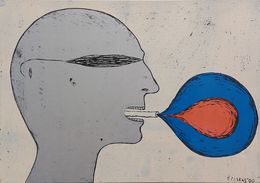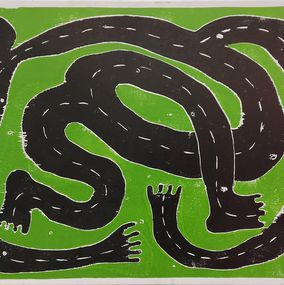
Presentation
The graphic art of Egmontas Bzeskas is an example of an entirely different kind of sign art. On his large-format canvases (the biggest is 14 m2), in most cases one or two objects find their place, but even they with great difficulty find enough room in this reservation of space. The laconic structure and suggestiveness call to mind enormous witty logotypes: they parade the poster form and clear drawing, they are informative, suggestive and full of optimism. They actively signal the viewer and energetically stick to the surroundings.
The arsenal of EB's means confines itself within a predatory, genderless space and several symbols. His favorite images are the human pictogram and the spiral. Both of them obviously ignore their historical origin, craving to be like the personages of an animated cartoon. The artist willingly helps them, giving them the opportunity to be reincarnated and the elastic form of the snake. The human becomes a spiral, the spiral becomes a snail, the snail becomes a human, the human becomes a labyrinth, the labyrinth becomes a stone, and so on. Each easily adapts itself into its new role and, "while every moment feeling the joy of existing", they gush with a frantic temperament. This phrase, borrowed from Camus, does not seem out of place in this context: the animated personages of EB especially enjoy playing Sisyphus with the rock.
The artist tries out other bodily metamorphoses, too. Often in his works strange creatures can be seen, constructed from several recognizable organs. EB behaves like a superstitious primitive artist (who tried to emphasize the most important places of the body), but the scale of values is changed: mouths and legs prevail. Reverse motion can be seen in the plasticity of these surrealistic neologisms: it is not the sign that turns into a live personage, but rather the reduced anthropomorphic forms that turn into a sign (moreover, keeping their distinguishing characteristics).
To find one's place in EB's scale of values is rather difficult. Contrary to his inspirer, Camus, the artist does not burden himself with existential considerations (the drama of Sisyphus impresses with its aspect of the absurd). His infantile characters are content with their present state of being despite its sometimes cheerless nuances. The author is delighted with the irrationality of his creatures, which is an opportunity to open an energy 'channel'. The centrifugal force of a compressed spiral serves this purpose very well: the different manipulations of his well-liked spiral. And, of course, harsh colors; their relationship with black creates a situation full of conflict automatically. The vital plasticity is tamed mildy by the derivatives of the composition that mostly pay heed to the center and other classical norms.
The woodcuts by EB, pressed on the large canvases, naturally coincide in the neighborhood of painters, but they don't renounce the privileges of the graphic arts. Here not only the slippery black tracks are valued, but the rough cloth, too; not only the common outlines, but also the inner sections — the mist of color, the texture of an uncoordinated stroke, the graceful intervention of a dotted line. But these works of complicated technology that don't lack subtlety do not attempt to impose with their professionalism; on the contrary, they make an impression of a loose, caricatured, childishly naive drawing. However, their simplicity and careless merriment are not marked by the weightlessness that is characteristic of naive art — the works of EB stand out with their strong dominance and suggestiveness.
Today, the artist's work is summarised in a nutshell as a new generation of hybrid graphics. 20 years ago, EB's enormously large woodcuts were printed on canvas and awarded the diploma/record for the largest printmaking work in Lithuania, freeing printmaking from the standards of small formats and framing, and bringing it a bit closer to painting. The artist's graphic art at that time was not only surprisingly distinctive, but also inspired the work of many young graphic artists, changing the traditional dogmas of graphic art at that time.
Today, the EB does not stop there, using the latest electronic technologies, various building materials, silicone, plastic, intelligent LED lighting, sound effects, and touch functions, thanks to which the viewer can partially engage in a direct conversation with the painting. The artist has long continued his own and others' themes of the shadow of people, integrating fragments of classical wood engravings. Carves/engraves wood blanks/mouldings together with the help of modern machinery/robot. The paintings have become content, and some of the protruding parts are 3D printed. QR codes are also integrated into the paintings, giving the viewer access to the deepest layers of the artwork. All these elements complement and reinforce the ideas conveyed by the artist and do not leave the viewer indifferent.
Art is a game, it is each of your journeys into the labyrinth of my paintings. It is a performance with all its inherent elements, physically squeezed between four sides, but unrestricted to expand in all infinite directions. Let's play together...



Defender of the Yellow Cactus Island
Egmontas Bzeskas
Print - 73 x 63 x 5 cm Print - 28.7 x 24.8 x 2 inch
Sold
Discover our selections of works by artists
What are their 3 main works?
When was Egmontas Bzeskas born?
